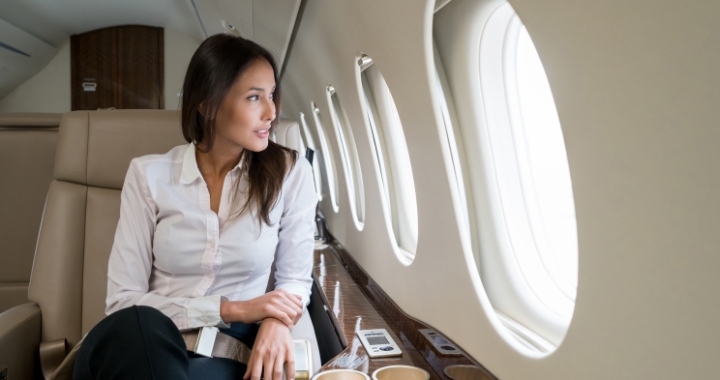Indulging in the luxury, comfort, and convenience of flying via private jet is a joy to many. However, it’s not uncommon for safety concerns to cast a shadow over this enticing mode of travel, causing some to hesitate. In this post, we dedicate ourselves to unraveling the safety intricacies of private jets, shedding light on the robust measures, advanced features, and dedicated training that make them a secure choice for air travel. Let’s delve into the world of private jet safety and put those concerns to rest.

How Safe Are Private Jets?
When it comes to air travel, safety is paramount. The question of how safe private jets are often arises, especially given the relatively smaller size of these aircraft compared to commercial planes. It’s however essential to understand that private jets are subject to rigorous safety standards, and the focus on safety is unwavering across all private jet companies.
Contrary to the occasional headlines about airplane crashes, the safety record of private jets is commendable. The truth is that pilot errors and weather conditions contribute significantly to accident rates in aviation. But private jet companies are keenly aware of these factors. They invest heavily in training their pilots and crew members, ensuring that they are well-equipped to handle a variety of situations that might arise during flights. Moreover, private jets often have access to smaller airports, allowing for a more controlled environment when it comes to takeoffs, landings, and navigation around unfavorable weather conditions.
Private Plane Safety Features
One of the key advantages of flying privately is that these aircraft often undergo stringent maintenance checks due to their exclusive use. This translates to a higher level of diligence in inspecting the planes for any issues that might otherwise go unnoticed in the hustle and bustle of commercial flights. Modern technology plays a pivotal role in enhancing safety as well. With advanced avionics systems, weather prediction tools, and communication networks, pilots of private jets can make well-informed decisions that prioritize the safety of their passengers.
The safety management systems in aviation, which include meticulous planning, adherence to safety protocols, and continuous training, are diligently followed in the private aviation sector. Private jet companies recognize the importance of these systems and work in tandem with organizations such as the National Transportation Safety Board (NTSB) to learn from incidents and improve safety measures further.
Statistics also paint a reassuring picture. Private jets undergo an average of 100,000 flight hours before being involved in an accident. When you consider that private planes are involved in a significantly lower number of fatal accidents compared to commercial airlines. It becomes evident that flying privately can be considered safer than commercial airlines.
Here are some private plane safety features:

Advanced Avionics Systems
Modern private jets are equipped with state-of-the-art avionics systems that incorporate GPS, radar, and collision avoidance technology. These systems provide real-time data to pilots, enabling them to navigate efficiently and avoid potential hazards. By seamlessly integrating weather updates and flight data, avionics systems empower pilots to make informed decisions, ensuring a safer journey for passengers.
Terrain Awareness and Warning System (TAWS)
TAWS is a cutting-edge technology that uses GPS and a detailed terrain database to warn pilots about potential ground collisions. By monitoring the aircraft’s altitude and surrounding terrain, TAWS provides timely alerts, allowing pilots to take corrective action and prevent accidents. Especially during low-visibility conditions or challenging approaches.
Collision Avoidance Systems
Private jets are equipped with Traffic Collision Avoidance Systems (TCAS) that use radar to detect nearby aircraft. TCAS issues advisories to pilots when another aircraft comes too close, helping them take evasive maneuvers to avoid potential collisions. This technology acts as an extra set of eyes in the sky. Enhancing situational awareness and minimizing the risk of mid-air incidents.
Enhanced Vision Systems (EVS)
EVS utilizes infrared sensors and advanced cameras to provide pilots with enhanced visibility. Even in challenging weather conditions or at night. By displaying real-time images on cockpit screens, EVS enables pilots to see through darkness, fog, or haze, ensuring safer landings and takeoffs.
Automated weather monitoring
Private jets are equipped with weather monitoring systems that continuously gather data about temperature, wind speed, and atmospheric conditions. Pilots can access this information in real-time. This enables them to adjust flight paths and altitudes to avoid turbulence and adverse weather, thereby ensuring a smoother and safer journey.

Private Jet Safety Statistics
If you are yet to be fully convinced of how safe private jets are, understanding the safety statistics of private jets in recent times can provide invaluable insights. Over the years, a noteworthy trend has emerged in private jet safety statistics. As the number of accidents and fatalities related to private planes has been steadily declining. This positive trend reflects the industry’s unwavering dedication to implementing and enhancing safety protocols. As well as the utilization of advanced technology to minimize potential risks.
Equally significant is the decline in fatalities associated with private plane accidents. As private jet companies prioritize safety management systems and invest in pilot training, the likelihood of fatal incidents occurring has diminished. This commitment to safety resonates not only with passengers but also with crew members. As they play a vital role in maintaining a secure and comfortable flight environment.
Private jet companies understand that a well-trained pilot is the cornerstone of safe air travel. Pilots are well-prepared through rigorous training programs to handle a variety of scenarios. Everything from adverse weather conditions to emergencies. The expertise and professionalism of these pilots contribute significantly to the declining accident rates in the private jet sector.
Cruise the skies safely without fear. You’re in good hands.
While the media occasionally highlights private plane crashes, the safety protocols private jet companies employ to make private jets safer are often less portrayed. The declining number of accidents and fatalities reflects their tireless efforts to uphold the highest safety standards. Safety remains a top priority across the private aviation industry. And, the dedication to ensuring secure and comfortable journeys is unwavering. So, if you’re considering flying privately, rest assured that your safety is in capable hands.
As you are cruising safely through the skies, ensure your jets are equipped with JetBed. The innovative product turns your jet seats into luxurious, comfortable beds for optimal in-air sleeping. It’s easy to use and lightweight, and with our large collection of options it fits almost every aircraft. There’s no reason it’s not available on every private aircraft you board!
Jetbed also offers the most comfortable bed linens for private jets, designed to provide ultimate comfort and sound sleep. Don’t settle for less when it comes to your comfort while flying; keep JetBed on your must-have list!

